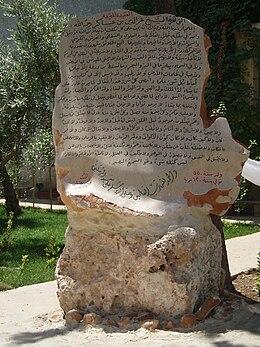|
Abu al-Qasim al-Ansari
al-Anṣārī, Abū l-Qāsim Salmān b. Nāṣir b. 'Imrān al-Arghiyānī al-Nīsābūrī al-Ṣūfī al-Shāfi'ī (Arabic: أبو القاسم الأنصاري), commonly known as Abu al-Qasim al-Ansari[1] was a Persian Sunni scholar known for being an Ash'arite theologian, Shafi'i jurist, traditionist, scriptural exegete and mystic during the Islamic Golden Age.[2][3] He was the famous pupil of Imam al-Haramayn al-Juwayni and greatly influenced by him, as can be seen by his own theological writings.[4] He was referred to as Sayf al-Nazr (Arabic: سيف النظر, lit. '"Sword of insight"').[2] As a Muslim scholar of the Sunni branch and Shafi'i school, his studies covered the fields of Islamic theology, Usul al-Din (principles of faith), Shafi'i jurisprudence, Sufism, Interpretation of Quran, and the studies of Hadith. Among his most prominent students were Al-Shahrastani, the author of Al-Milal wa al-Nihal, and Ibn al-Sam'ani, the author of Kitab al-Ansab.[3] He lived under the Abbasid Caliphate, between the second half of the fifth century AH and beginning of the sixth century AH of the Islamic calendar.[5] Name
Al-Ansari's full name was "Salman bin Nasser bin Imran bin Muhammad bin Ismail bin Ishaq bin Yazid bin Ziyad bin Maymoon bin Mahran, Abu al-Qasim, Ansari al-Nisaburi". Some of those who translated Al-Ansari disagreed with this designation, instead used "Suleiman" in the place of "Salman". Perhaps this is due to a misrepresentation in the copies of the books in which it was mentioned that he was named after Solomon. Due to the large number of people who called him "Salman" from those who translated for him, as well as the closeness of the two names in form, the two names were mixed up during the translation. There is an anecdote that confirms his name to be Salman from records of Ibn Qadi Shahba (Arabic: ابن قاضي شهبة), in which it was mentioned that al-Ansari personally corrected his name in the sentence: "Salman opened the Seine" (Arabic: سلمان بفتح السين).[5] LifeAl-Ansari grew up in a town on the outskirts of Nishapur of Transoxiana, which is located in the northeastern part of modern-day Iran. At the time the area was under the control of the Seljuk Empire.[5] In his early age, Al-Ansari spent time under the apprenticeship to Fadlallah Al-Mehani (Arabic: فضل الله الميهني), the then Sheikh of Khorasan. Al-Ansari was among those whom he narrated the hadith to on the authority of Zaher bin Ahmed Al-Sarkhasi (Arabic: زاهر بن أحمد السرخسي).[5] Around 465 AH (1073 CE), Abu al-Qasim studied in Nishapur under some of the foremost leading scholars of his day. After completing his studies, he visited Baghdad and went to Hajj. He migrated to Levant, and visited the graves of Islamic prophets. He kept an ascetic and pious lifestyle during his travels and studies.[4][6] TeachersAl-Ansari also spent time serving and learning from the following scholars:[5]
PupilsSome of the most notable individuals among his students were:[5]
DeathAround the last few years of his life, Al-Ansari suffered from poor eyesight and tinnitus. The majority of those who translated for him agreed that his death was in the year 512 AH (1118 CE).[7] Some of the sources specified that he died in the month of Jumada al-Akhir (the 6th month of Islamic calendar). In contrary, a number of accounts, such as the ones made by Al-Dhahabi, Al-Suyuti and Ahmed bin Muhammad al-Adnroy (Arabic: أحمد بن محمد الأدنروي) claimed that Al-Ansari died in the year 511 AH (1117 CE) instead.[8] His StudiesAl-Ansari had complied materials from several imams concerning the Usul al-Din (principles of faith). In his work Al-Ghaniat fi al-Kalam and Al-Ghaniyaa Dariyyah, he also weighted the authenticity of many hadiths, including the ones on:
Out of the hadiths that Al-Ansari examined in the theology section of his book Al-Ghaniyaa Dariyyah, he said that 88 hadiths can be attributed to Muhammad, and 44 were sayings from the companions and followers of Muhammad. Works
See alsoReferences
|
||||||||||||||||||||||||||||||||||||||||||||||
Portal di Ensiklopedia Dunia


